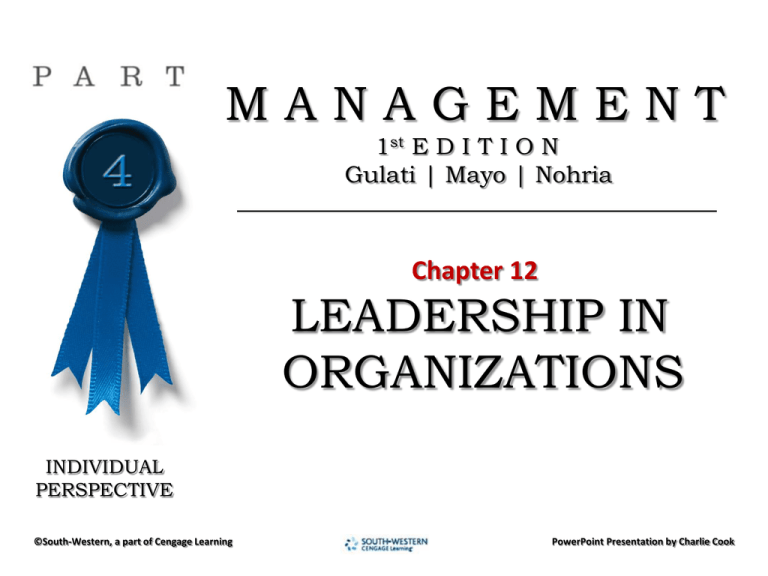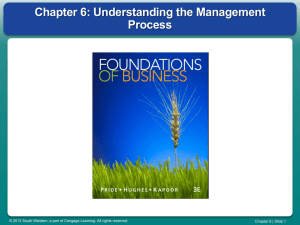Management 1e - Cengage Learning
advertisement

MANAGEMENT 1st E D I T I O N Gulati | Mayo | Nohria Chapter 12 LEADERSHIP IN ORGANIZATIONS INDIVIDUAL PERSPECTIVE ©South-Western, a part of Cengage Learning PowerPoint Presentation by Charlie Cook Learning Objectives • Explain why the study of leadership is so complicated and identify some of the various debates about the study of leadership • Describe the different theories of leadership that have emerged from the study of individual readers • Describe how leaders are influenced by followers and describe the theories of leadership that have been derived from analyzing the leader-follower dynamic • Explain how the situational context influences the exercise of leadership © South-Western, a part of Cengage Learning 12–2 The Leader: Who is a Leader? Traits and Skills “Great Man” theory Explained leadership by examining the traits and characteristics of individuals considered to be historically great leaders Traits-based leadership theory Tries to reveal a set of universal traits and skills that are relevant in all leadership situations Common leadership traits © South-Western, a part of Cengage Learning • • • • • • Self-confidence Initiative Risk taking Persistence High level of physical energy Motivation to complete tasks 12–3 Leadership Skills Cognitive skills A leader’s ability to understand the internal and external environments, make decisions with sound reasoning, and communicate effectively Technical skills A leader’s knowledge about an organization and job-related activities Interpersonal skills Character © South-Western, a part of Cengage Learning A leader’s ability to interact with others The core values and fundamental beliefs that drive behavior in variable situations 12–4 Leadership Style The pattern of behaviors that leaders use in situations Task-oriented behavior Behaviors that prioritize the accomplishment of a task in an efficient and reliable way Relationsoriented behavior Behaviors that prioritize interpersonal relationships, the value of workers as humans, and a strong commitment to the unit and its mission © South-Western, a part of Cengage Learning 12–5 Figure 12.1 - The Managerial Grid © South-Western, a part of Cengage Learning 12–6 The Charismatic Leader Individuals who arouse strong followership through inspirational visions and/or compelling personal attributes Charismatic leaders • Exhibit extreme self-confidence about their values Patterns in charismatic leaders • Possess willingness to take personal risks • Have a strong moral conviction to exercise their power positively • Communicate vision through powerful imagery, symbolism, and metaphor © South-Western, a part of Cengage Learning 12–7 Transformational Leadership Theory Transformational leadership Components of transformational leadership © South-Western, a part of Cengage Learning The set of behaviors that leaders use to transform, or change, their organization and individuals for the better • Charisma and vision • Inspirational motivation • Intellectual stimulation • Individualized consideration 12–8 Transactional Leadership Theory Transactional leadership Components of transactional leadership © South-Western, a part of Cengage Learning The process of a leader providing something the subordinates want • Contingent reward • Active management-by-exception • Passive management-by-exception 12–9 Components of Transactional Leadership Contingent reward Management-byexception © South-Western, a part of Cengage Learning The exchange process between leaders and followers in which leaders offer rewards to subordinates in exchange for their services A method of leadership done passively or actively that describes when leaders should intervene to increase a subordinate’s effort to meet standards 12–10 Leader-Member Exchange Theory Leader-member exchange (LMX) theory A method of leadership in which leaders treat each member differently, and as a result, develop unique relationships with each member In-groups Favored subordinates Out-groups Favored subordinates who are assigned more interesting tasks, given greater responsibility and authority, and receive more tangible rewards and more resources Subordinates who are expected to simply comply with formal rules and do what is required of them; as a result, they receive the standard benefits of the job © South-Western, a part of Cengage Learning 12–11 The LMX Relationship Life Cycle: The Role-Making Process Relationship life cycle Phases in which a leader and follower undergo a process that dictates whether followers become part of the in-group or out-group 1 Stranger phase - Leaders and subordinate interactions are formal and based on organizational policies 2 Acquaintance phase - When a leader offers the subordinate a chance to increase his or her responsibility in the group and the subordinate must accept the new role 3 Mature partnership phase - Leaders and followers develop strong mutual trust, respect, and obligation © South-Western, a part of Cengage Learning 12–12 The Leader, the Followers, and the Situation Fiedler contingency model Leaders are more effective depending on the favorability of a leadership situation, which is described by leadermember relations, task structure, and positional power of the leader Leader-member relations • Quality of relationships between leaders and followers Task structure • Extent to which standard procedures are in place to complete a task Positional power • Extent to which a leader has authority to evaluate performance and administer rewards or punishments © South-Western, a part of Cengage Learning 12–13 Hersey and Blanchard’s Situational Theory Situational leadership theory Leaders have the flexibility and range of skills to adapt their leadership behavior. This type of leadership is based on the interplay of: 1 The amount of task-related behaviors a leader exhibits 2 The amount of relationship-related behaviors a leader exhibits 3 The level at which followers are mature enough to perform a specific task, function, or objective © South-Western, a part of Cengage Learning 12–14 Figure 12.2 - Leadership Styles Mapped to Subordinates’ Characteristics © South-Western, a part of Cengage Learning 12–15 House’s Path-Goal Theory Path-goal theory of leadership Task characteristics The most important aspect in leadership is the follower’s expectation that a task can be accomplished and that it will lead to rewards Leader behaviors Subordinates’ characteristics • Structured or unstructured • Directive • Participative • Preferences for structure • Repetitive or diverse • Supportive • Desire for control • Achievementoriented • Confidence in ability • Simple or complex © South-Western, a part of Cengage Learning 12–16 Leadership Substitutes and Neutralizers Substitutes Neutralizers © South-Western, a part of Cengage Learning Aspects of a situation that make leadership unnecessary Aspects of a situation that hinder a leader’s ability to act a particular way 12–17 KEY TERMS Character Charismatic leaders Cognitive skills Contingent reward Fiedler contingency model “Great Man” theory Interpersonal skills Leader-member exchange theory Leadership neutralizers Leadership style Leadership substitutes Management-by-exception © South-Western, a part of Cengage Learning Managerial grid Path-goal theory of leadership Relationship life cycle Relations-oriented behavior Situational leadership Task-oriented behavior Technical skills Traits-based leadership theory Transactional leadership Transformational leadership 12–18




